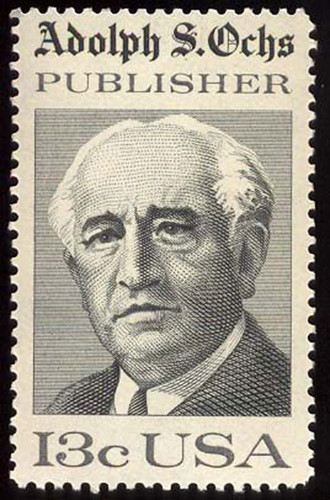Americana: New York
27 Apr - 15 May 2010
AMERICANA: NEW YORK
Home of America's Newspaper of Record
Mary Augustine Gallery | Apr. 27–May 15, 2010
First published in 1851 by Henry Jarvis Raymond and George Jones, The New York Times is known in the publishing world as "The Gray Lady." It is one of the oldest continuously-running newspapers in the United States and considered "the newspaper of record." Coined by publisher Adolph S. Ochs in 1897, the paper's motto "All the News That's Fit to Print" is a daily reminder of the journalistic standards of the paper. Today, The New York Times is still considered one of the most prestigious papers in the world having won 104 Pulitzer Prizes, more than any other paper in the country.
The New York Times has also come to carry a certain cache in popular culture for its representation of a cosmopolitan lifestyle. An avid reader of The Times is interested in national and international events, religion, business, sports, cars, the arts, society and fashion. Its crossword has become a yardstick for intelligence and cunning. This self-branding by The Times is evident in their other publications presented here in this exhibition: cookbooks, anthologies, histories, and decorating books. These lifestyle guides have been culled from their own previously printed pages and compiled in one handy book for the consumption of their readers.
However, also on display are independently published histories and exposés of the paper. These books criticize and question the role of The Times in American history and its management by the Sulzberger-Ochs dynasty. Seth Mnookin's Hard News tells the story of Jayson Blair's fabrications within The New York Times and how it has affected the paper and journalism within the country. Other books criticize The Times for not only being factually inaccurate, but for their liberal bias and elitism like Ann Coulter's How to Talk to a Liberal (if you must). These critiques of The New York Times highlight the way in which the paper has come to represent a certain lifestyle and ideology in American culture, good or bad.
Curated by Emily Gonzalez
Home of America's Newspaper of Record
Mary Augustine Gallery | Apr. 27–May 15, 2010
First published in 1851 by Henry Jarvis Raymond and George Jones, The New York Times is known in the publishing world as "The Gray Lady." It is one of the oldest continuously-running newspapers in the United States and considered "the newspaper of record." Coined by publisher Adolph S. Ochs in 1897, the paper's motto "All the News That's Fit to Print" is a daily reminder of the journalistic standards of the paper. Today, The New York Times is still considered one of the most prestigious papers in the world having won 104 Pulitzer Prizes, more than any other paper in the country.
The New York Times has also come to carry a certain cache in popular culture for its representation of a cosmopolitan lifestyle. An avid reader of The Times is interested in national and international events, religion, business, sports, cars, the arts, society and fashion. Its crossword has become a yardstick for intelligence and cunning. This self-branding by The Times is evident in their other publications presented here in this exhibition: cookbooks, anthologies, histories, and decorating books. These lifestyle guides have been culled from their own previously printed pages and compiled in one handy book for the consumption of their readers.
However, also on display are independently published histories and exposés of the paper. These books criticize and question the role of The Times in American history and its management by the Sulzberger-Ochs dynasty. Seth Mnookin's Hard News tells the story of Jayson Blair's fabrications within The New York Times and how it has affected the paper and journalism within the country. Other books criticize The Times for not only being factually inaccurate, but for their liberal bias and elitism like Ann Coulter's How to Talk to a Liberal (if you must). These critiques of The New York Times highlight the way in which the paper has come to represent a certain lifestyle and ideology in American culture, good or bad.
Curated by Emily Gonzalez

